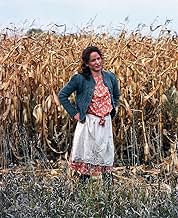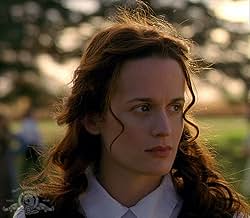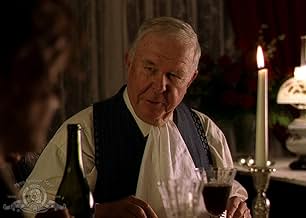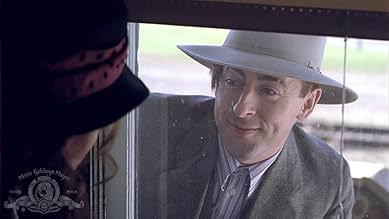AVALIAÇÃO DA IMDb
7,1/10
4,3 mil
SUA AVALIAÇÃO
Adicionar um enredo no seu idiomaIn 1920, Inge, a German national, travels from Norway to rural Minnesota for her arranged marriage to Olaf, a Norwegian farmer; bureaucracy and prejudice cause major complications.In 1920, Inge, a German national, travels from Norway to rural Minnesota for her arranged marriage to Olaf, a Norwegian farmer; bureaucracy and prejudice cause major complications.In 1920, Inge, a German national, travels from Norway to rural Minnesota for her arranged marriage to Olaf, a Norwegian farmer; bureaucracy and prejudice cause major complications.
- Prêmios
- 9 vitórias e 2 indicações no total
- Direção
- Roteiristas
- Elenco e equipe completos
- Produção, bilheteria e muito mais no IMDbPro
Avaliações em destaque
As a total movie addict, I was very surprised after attending a screening of this film to be so overwhelmed by the quality of the photography and the depth of the acting.
The visual images in this film are simple, yet breathtakingly beautiful in their composition. It is a rare masterpiece with amazing use of time, depth and perspective. The development of the romantic tension between the main characters in the love story was so powerful and yet so subtle, that it was like a fresh breath mint on a cold January morning.
The used of time and flashbacks is amazing, and the editing and pace of the movie is very accomplished for an independent, low budget film. I will not be surprised if I hear about this move at Oscar time.
The visual images in this film are simple, yet breathtakingly beautiful in their composition. It is a rare masterpiece with amazing use of time, depth and perspective. The development of the romantic tension between the main characters in the love story was so powerful and yet so subtle, that it was like a fresh breath mint on a cold January morning.
The used of time and flashbacks is amazing, and the editing and pace of the movie is very accomplished for an independent, low budget film. I will not be surprised if I hear about this move at Oscar time.
i knew nothing about it before i saw sweet land at a film "class" preview. what a wonderful surprise. it is slow, thoughtful, with frames that are like beautiful photographs. the director gets more across with silence and facial expressions than most dialogue does. the actors are unique individuals - each performance a gem. and, the story is touching - the decent salt of the earth assimilated farmers who feel threatened by "other" outsiders. the two main characters beautifully portrayed as they work side by side and get to know each other. unique heartland music that respects the acting and dialogue and enhances without taking over at all. i highly recommend this for filmgoers who want to be touched and immersed. kudos to ali selim and fine company.
10takng
Sweet Land touched my heart. My roots are from the same farming background as Olaf and Inge's. Seeing them brought back stories and memories of my own growing up and family history. It slowed down the pace for just a little while and brought back into focus what should really matter in life--and that is the people you journey though it with. The story is simple and yet it is far deeper and more touching than most movies that hit the screen today. It is a story of hardship and the joy and pride that come from hard work. It is a love story and a story of strength. And it is a story with humor and valuable lessons that I believe America's heartland was raised on. It also shares a mindset of a time gone by, an understanding of why our grandparents and parents thought as they did and believed the things they believed. When we know and understand the past, it helps shape and lead us to the future. I appreciate the time and energy that went into the making of this film. It is a treasure.
Delightful, richly imagined story of a young immigrant woman who comes from Norway to Minnesota in 1919 as a "mail order bride" to marry a Norwegian farmer. By turns slapstick funny, tender, ironic and sad, this movie successfully evokes the difficult life of foreign homesteaders in a new land, in a story told simply, with no pretensions and with a wondrous range of nuances.
We confront outrageous instances of religious, ethnic and political bigotry, and the cruel predations of wealthy money lenders who don't blink an eye when pressing foreclosures, ruining families who have sat elbow to elbow with them at church every Sunday for years. But we also see examples of kindheartedness, longing for love and gradually dawning romance, individual integrity and group justice, not to mention hilarious moments, both intentional and unintended.
Inge (Elizabeth Reaser, a luminous beauty) is the stalwart German woman who comes to marry the reticent Olaf (Tim Guinee), who had thought she was Norwegian like him, since she came from a town in Norway. Olaf is a character straight out of a Garrison Keillor monologue: he's the quintessential shy Norwegian bachelor farmer.
Inge, on the other hand, is deferential only because she can't speak English or Norwegian, only German, and that only with the church pastor, Rev. Sorrensen (John Heard), who refuses to conduct the wedding because Inge has no citizenship papers and, ironically, he is suspicious of her German roots, in a time when anti-German sentiment was still at a peak following WW I. Once Inge's got a handle on language, she starts to show her pluck, for, beneath her stunning physical beauty, Inge is in fact a forceful woman.
Comic relief is afforded in a marvelous turn by Alan Cumming as Frandsen, another - and altogether inadequate farmer. Rather than actually work at farming, Frandsen would much rather entertain his wife and nine kids, and his friends, with funny gestures and tunemaking. Cumming's performance reminds me of Ray Bolger as the scarecrow in Wizard of Oz, or Håkan Hagegård, as Papageno in Bergman's "The Magic Flute," or some of the masters of physical comedy in the silent film era. Rounding out a superb cast are Ned Beatty as Harmo, a ruthless banker, and Alex Kinston as Frandsen's wife, Brownie.
Director Ali Selim, a native of St. Paul, Minnesota, had a highly successful career making commercials for television before undertaking this picture, his debut feature narrative film. He worked from a short story by Bemidji writer Will Weaver, called "Gravestone Made of Wheat." The movie was shot on location in a rural area of southwest Minnesota. This film will leave you laughing and crying. It is a treasure. (In English, German and Norwegian) My grades: 8.5/10 (A-) (Seen on 12/26/06)
We confront outrageous instances of religious, ethnic and political bigotry, and the cruel predations of wealthy money lenders who don't blink an eye when pressing foreclosures, ruining families who have sat elbow to elbow with them at church every Sunday for years. But we also see examples of kindheartedness, longing for love and gradually dawning romance, individual integrity and group justice, not to mention hilarious moments, both intentional and unintended.
Inge (Elizabeth Reaser, a luminous beauty) is the stalwart German woman who comes to marry the reticent Olaf (Tim Guinee), who had thought she was Norwegian like him, since she came from a town in Norway. Olaf is a character straight out of a Garrison Keillor monologue: he's the quintessential shy Norwegian bachelor farmer.
Inge, on the other hand, is deferential only because she can't speak English or Norwegian, only German, and that only with the church pastor, Rev. Sorrensen (John Heard), who refuses to conduct the wedding because Inge has no citizenship papers and, ironically, he is suspicious of her German roots, in a time when anti-German sentiment was still at a peak following WW I. Once Inge's got a handle on language, she starts to show her pluck, for, beneath her stunning physical beauty, Inge is in fact a forceful woman.
Comic relief is afforded in a marvelous turn by Alan Cumming as Frandsen, another - and altogether inadequate farmer. Rather than actually work at farming, Frandsen would much rather entertain his wife and nine kids, and his friends, with funny gestures and tunemaking. Cumming's performance reminds me of Ray Bolger as the scarecrow in Wizard of Oz, or Håkan Hagegård, as Papageno in Bergman's "The Magic Flute," or some of the masters of physical comedy in the silent film era. Rounding out a superb cast are Ned Beatty as Harmo, a ruthless banker, and Alex Kinston as Frandsen's wife, Brownie.
Director Ali Selim, a native of St. Paul, Minnesota, had a highly successful career making commercials for television before undertaking this picture, his debut feature narrative film. He worked from a short story by Bemidji writer Will Weaver, called "Gravestone Made of Wheat." The movie was shot on location in a rural area of southwest Minnesota. This film will leave you laughing and crying. It is a treasure. (In English, German and Norwegian) My grades: 8.5/10 (A-) (Seen on 12/26/06)
This film is most absorbing, but you have to be willing to watch a film that unfolds slowly. It is magnificently acted with two young actors -- Elizabeth Reaser and Tim Guinee as the leads. There is relatively little dialogue, and much of it is in German or Norwegian with no subtitles, which conveys to the audience the difficulty that they have communicating with each other.
The two leads are heavily dependent upon the expressiveness of their eyes, which they do with great delicacy. The film is well-paced and beautifully photographed. The only difficulty I had was catching on that the action took place in three time periods, not just two. You had 1920 when Inge, a mail order bride comes to rural Minnesota. (The scenery looked authentic, and since some of the credits are for institutions in Montevideo, MN, a town to which I once traveled, I can understand the veracity of the setting.)
The second time period, which is not so clear, is when Olaf, Inge's husband has passed away, and the third time period is more or less the present when Inge's grandson is faced with a decision of whether or not to sell the farm. There are some visual clues to separate the second and third time periods, but they are quite subtle.
The second is probably around 1960, marked by the glasses frames that Inge, as an old woman is wearing; and the third, by a jacket that her great-granddaughter is wearing. Otherwise, the time differences are not totally clear, particularly at the beginning of the film, where you have flashbacks.
The film struck me with its apparent accuracy. Twenty years ago, I knew an elderly Norwegian immigrant who had been the wife of a North Dakota farmer, and she had told me stories of farm life in the 1920s and 1930s. It required about 15 people to operate a steam threshing machine, and she told me about preparing lunch each day during the harvest season for 20 men; and about reading by candlelight at night; using an indoor pump at the sink; and seeking to keep warm during the brutal North Dakota winters.
I visited the woman and her daughters and grand-daughter in her modern apartment which was a far cry from life during her youth. It blows me away to think about the change in this one woman's singular life from her youth to her later years -- greater changes than in any prior period in history. (In 1946, there were still more horse drawn tractors than mechanized ones in use in the U.S., and there wasn't much electricity in rural areas until the New Deal.)
Although I may have missed some, I perceived no wrong notes in the film which added to the enjoyment of watching it. A most charming film from beginning to end.
The two leads are heavily dependent upon the expressiveness of their eyes, which they do with great delicacy. The film is well-paced and beautifully photographed. The only difficulty I had was catching on that the action took place in three time periods, not just two. You had 1920 when Inge, a mail order bride comes to rural Minnesota. (The scenery looked authentic, and since some of the credits are for institutions in Montevideo, MN, a town to which I once traveled, I can understand the veracity of the setting.)
The second time period, which is not so clear, is when Olaf, Inge's husband has passed away, and the third time period is more or less the present when Inge's grandson is faced with a decision of whether or not to sell the farm. There are some visual clues to separate the second and third time periods, but they are quite subtle.
The second is probably around 1960, marked by the glasses frames that Inge, as an old woman is wearing; and the third, by a jacket that her great-granddaughter is wearing. Otherwise, the time differences are not totally clear, particularly at the beginning of the film, where you have flashbacks.
The film struck me with its apparent accuracy. Twenty years ago, I knew an elderly Norwegian immigrant who had been the wife of a North Dakota farmer, and she had told me stories of farm life in the 1920s and 1930s. It required about 15 people to operate a steam threshing machine, and she told me about preparing lunch each day during the harvest season for 20 men; and about reading by candlelight at night; using an indoor pump at the sink; and seeking to keep warm during the brutal North Dakota winters.
I visited the woman and her daughters and grand-daughter in her modern apartment which was a far cry from life during her youth. It blows me away to think about the change in this one woman's singular life from her youth to her later years -- greater changes than in any prior period in history. (In 1946, there were still more horse drawn tractors than mechanized ones in use in the U.S., and there wasn't much electricity in rural areas until the New Deal.)
Although I may have missed some, I perceived no wrong notes in the film which added to the enjoyment of watching it. A most charming film from beginning to end.
Você sabia?
- CuriosidadesElizabeth Reaser' Norwegian pronunciation was so bad that after Dagbladet (one of Norway's biggest news-papers) stumbled upon this film, they posted a clip from it with the title "What is she trying to say?"
- Erros de gravaçãoThey harvest an entire field of corn between the two of them, when they get back to the barn, the crop is suddenly wheat. They go through the whole "separating the wheat from the chaff" process, and pour the seed into sacks.
- Citações
Old Inge: Olaf died, Frandsen.
Old Frandsen: [considering for a moment] No. Olaf is in the fields.
Old Inge: [slowly glancing out the window and remembering]
- Trilhas sonorasEskimo Kisses
Music and Lyrics by Thomas Lieberman (as T.F. Lieberman)
Published by Liza Rose Music (ASCAP)
Performed by Thomas Lieberman (as Tom Lieberman)
Principais escolhas
Faça login para avaliar e ver a lista de recomendações personalizadas
- How long is Sweet Land?Fornecido pela Alexa
Detalhes
- Data de lançamento
- País de origem
- Central de atendimento oficial
- Idiomas
- Também conhecido como
- Sweet Land
- Locações de filme
- Empresas de produção
- Consulte mais créditos da empresa na IMDbPro
Bilheteria
- Orçamento
- US$ 1.000.000 (estimativa)
- Faturamento bruto nos EUA e Canadá
- US$ 1.706.325
- Fim de semana de estreia nos EUA e Canadá
- US$ 41.860
- 15 de out. de 2006
- Faturamento bruto mundial
- US$ 1.843.537
- Tempo de duração
- 1 h 50 min(110 min)
- Cor
- Mixagem de som
- Proporção
- 1.85 : 1
Contribua para esta página
Sugerir uma alteração ou adicionar conteúdo ausente


































